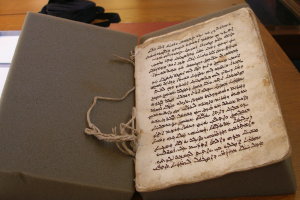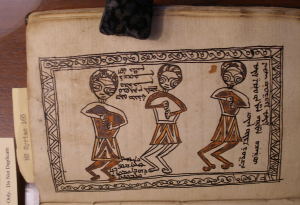Syriac Infancy Gospel of Thomas: Edition in Progress (Part 2)
When I returned to examining the Syriac Infancy Thomas tradition in 2008 I began with the Vatican manuscript translated in part (chs. 5-8 only) by Paul Peeters in 1914. He stated at the time that the manuscript was superior to William Wright’s sixth-century manuscript, despite its much more recent date of composition (17th century), because it contains portions missing in Wright. It was simple to obtain a microfilm copy of the Vatican manuscript and, being recent, it was quite easy to read. I could only wonder why it had taken so long for anyone to follow up on Peeters’ “superior” source.
I debuted the new text and translation at the 2008 Réunion de l’AELAC to largely positive response. However, Sever Voicu, well-known as a leading voice on Infancy Thomas, commented that the manuscript was so recent that it could hardly be important for reconstructing the text. Voicu’s resistance may stem from his belief that the Ethiopic tradition of the text is the best witness to its original form. After some revision, I submitted the paper to l’AELAC’s journal Apocrypha in September 2009 and waited for a response.

In the meantime I began investigating unpublished manuscripts of the text. Back in 1994, Simon Mimouni had prepared a study of Life of Mary traditions for Apocrypha (“Vies de la Vierge. État de la question,” Apocrypha 5 [1994]: 211-48) that I had somehow missed when preparing my dissertation. He had combed the manuscript catalogs and divided the Life of Mary sources into two streams: a Western (or Jacobite) recension combining Protevangelium of James, Infancy Thomas, the Vision of Theophilus, and the Assumption of Mary into a six-book collection; and the Eastern (Nestorian) recension represented by Budge’s Life of Mary text, which combines the Protevangelium of James, the Egyptian miracles, the Assumption of Mary, and, in some manuscripts, Infancy Thomas into one lengthy narrative. I tracked down as many of these manuscripts as possible—some had been lost or destroyed over the past century due to unrest in the East. My initial work on these Life of Mary traditions was presented at the 2008 Annual Meeting of the SBL under the title: “The Infancy Gospel of Thomas in the Jacobite Syriac Tradition.”
Some of the manuscripts in Mimouni’s list still eluded me because they had not been photographed. Fortunately, all of these were located in US libraries. Road trip! I applied for a small grant in 2010 that enabled me to travel to the Union Theological College in New York, Princeton, and Harvard and photograph four manuscripts: two East Syriac and two West. By the end of the trip I was able to finetune Mimouni’s list, correcting some of his identifications and adding some manuscripts that he had missed. I also adjusted Mimouni’s categories by dividing the evidence into three recensions: Sa (what I call the “early text,” featuring Infancy Thomas as a separate text, and including the manuscripts edited by Wright, Peeters, and Baars-Heldermann along with another manuscript very similar to Peeters’ from the Mingana collection), Sw (the West Syriac text, at this point known in 19 Syriac MSS and four in Garshuni), and Se (the East Syriac text, found now in three of 19 of the Life of Mary manuscripts).

In 2011 I once again presented my work on the text at the Réunion de l’AELAC in a paper entitled “On the Critical Edition of the Syriac Infancy Gospel of Thomas” and then at SBL in 2012 with “The Childhood of Jesus in the East Syriac Life of Mary.” While at AELAC I inquired about my submission to Apocrypha and learned that the editors still had not even read the paper. For reasons that I’d be happy to share over an adult beverage some time, my relationship with AELAC had soured by this point and I no longer felt welcome among the group. It seemed best to take my work elsewhere. So, I pulled the paper, updated it with the results of my manuscript hunting work and sent it off to Hugoye, who published it in 2013 as “The Infancy Gospel of Thomas from an Unpublished Syriac Manuscript. Introduction, Text, Translation, and Notes” (Hugoye 16.2: 225-99, available online HERE).
I planned originally to publish my critical edition of the three Syriac recensions in l’AELAC’s series Corpus Christianorum Series Apocryphorum, the same series that published my dissertation. But, again, AELAC and I were parting ways, so I secured a contract with Gorgias Press to publish the edition with them. Everything was ready. I had all of the manuscripts collated and had begun writing the introduction, so I told Gorgias to expect my finished work in September 2013. What went wrong?
Next: more &%#$ manuscripts!
